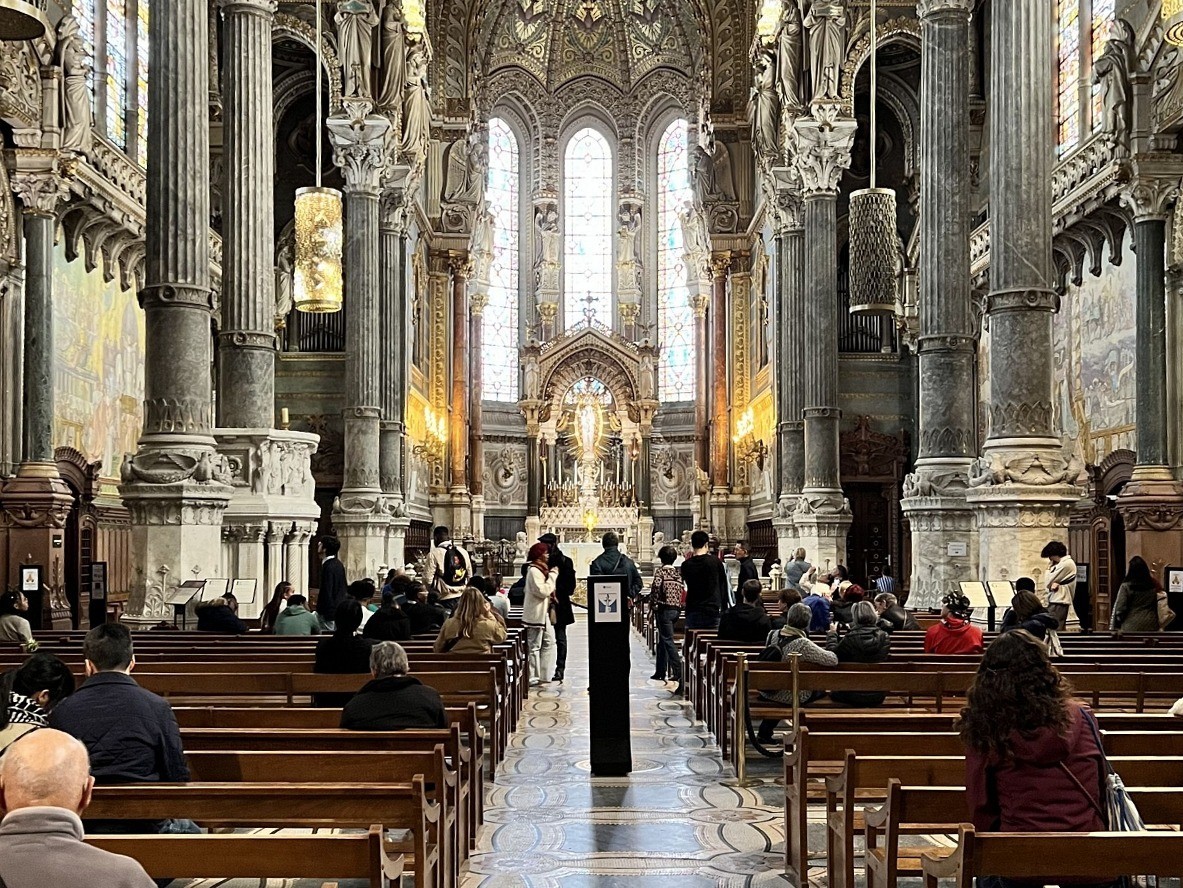RoamingXplorer takes you on an immersive journey through France’s Basilica of Notre Dame, revealing its stunning architecture, history, and hidden details through virtual exploration.
Perched high on Fourvière Hill, the Basilica of Notre Dame de Fourvière stands as a timeless symbol of faith and resilience, offering visitors a unique glimpse into Lyon’s spiritual and cultural history. My visit to this iconic site was a journey that not only deepened my appreciation for the city but also revealed the many layers of devotion, artistry, and significance tied to this sacred monument.


A Symbol of Faith: History Woven into Lyon’s Story
The Basilica of Notre Dame de Fourvière is more than just an architectural marvel; it’s a monument born out of devotion. Its origins are rooted in the collective prayers of Lyon’s citizens, seeking protection from calamities that have threatened the city throughout history.
In 1643, a devastating plague swept across Europe, and the people of Lyon, fearing the worst, made a solemn vow to the Virgin Mary, asking for her protection. When the city was spared from the worst of the plague, they fulfilled their promise by constructing a small chapel atop Fourvière Hill. This early act of devotion laid the foundation for what would later become one of Lyon’s most famous landmarks.
Fast forward to the late 19th century, during the Franco-Prussian War. Once again, Lyon found itself in peril, and once again, the people turned to the Virgin Mary. They pledged to build an even grander basilica if the city was protected from invasion. True to their word, when the war ended, construction began in 1872, and by 1884, the stunning Basilica of Notre Dame de Fourvière was completed, forever altering the city’s skyline.
The basilica’s history is a testament to the strength and unity of Lyon’s people, who, through every trial, turned to faith as a source of hope and strength. Walking through its halls, I couldn’t help but feel connected to this centuries-old story of resilience, a story that has become woven into the very fabric of the city.
The Ascent: Climbing Towards Serenity
One of the most memorable aspects of my visit to the Basilica was the journey itself. While there are several ways to reach the top of Fourvière Hill, I chose to walk. Starting in the charming streets of Vieux Lyon, the narrow-cobbled alleys meander up the hill, offering fleeting glimpses of the basilica as you climb higher. Each step felt symbolic, like a slow pilgrimage to a place of great spiritual significance.
The path is steep in parts, but the effort is worth every bit. As I paused to catch my breath, I couldn’t help but take in the stunning views that slowly unfolded below. The city of Lyon stretched out in all directions, with the Rhône and Saône rivers carving elegant lines through the red-tiled rooftops. The further I ascended, the more I could appreciate Lyon’s harmonious blend of history and modernity.
For those not keen on walking, the funicular offers a quicker and easier ascent. It departs from Vieux Lyon and swiftly carries passengers to the top of Fourvière Hill, depositing them right at the basilica’s doorstep. Regardless of how you choose to reach the summit, the arrival at the basilica feels like a reward in itself.

First Impressions: A Beacon of Faith Above the City
As I approached the basilica, its gleaming white façade dominated the skyline, a stark contrast to the city’s red rooftops below. The exterior design is a fascinating blend of Romanesque and Byzantine styles, a vision brought to life by the architect Pierre Bossan. Four imposing octagonal towers stand like sentinels at each corner, framing the basilica’s bulk with a sense of strength and grandeur. It’s a structure that feels simultaneously graceful and formidable, a tribute to faith’s ability to endure through time.
Stepping closer, I was drawn to the intricate details carved into the stonework. Figures of saints, angels, and religious symbols adorn every inch of the façade, each telling a story of devotion and protection. The basilica’s position atop the hill, gazing out over the city, gave me the impression that it watches over Lyon like a guardian, providing comfort and reassurance to all who pass below.
Inside the Basilica: A Mosaic of Faith and Art
Crossing the threshold into the basilica, I was immediately enveloped in a kaleidoscope of color. The interior of Notre Dame de Fourvière is nothing short of spectacular. Mosaics cover nearly every surface, shimmering in hues of gold, blue, and deep reds. These vibrant depictions of biblical scenes are brought to life with intricate craftsmanship, each one telling a part of Lyon’s spiritual narrative.
The contrast between the stark white exterior and the richly adorned interior is striking. The inside feels alive, almost pulsing with the energy of centuries of devotion. Everywhere I looked, there was something beautiful to absorb, whether it was the glittering gold details that caught the light or the rich stained-glass windows casting soft, multi-colored rays across the pews.
Standing beneath the basilica’s towering ceiling, I was struck by the sheer scale of the space. It felt as though the building itself was reaching toward the heavens, a gesture of both reverence and grandeur. I paused, taking in the immense beauty and spiritual weight of the place, grateful for the quiet moment of reflection it provided.
The Crypt: A Quiet Sanctuary of Solitude
While the basilica’s main hall dazzles with its opulence, the crypt below offers a more intimate, contemplative space. Dedicated to Saint Joseph, the crypt is simple in design, its muted tones a sharp contrast to the vibrant mosaics above. There’s a peacefulness here, a kind of quiet solace that invites reflection.
I found myself drawn to this sanctuary. The cool stone walls and the subdued light created an atmosphere perfect for meditation, a stark reminder that spiritual significance isn’t always found in grandeur. Sometimes, it’s in the quiet moments, in places where simplicity allows for deeper thought.
The Terrace: A View Unlike Any Other
One of the highlights of my visit was undoubtedly the view from the basilica’s terrace. From this vantage point, Lyon unfurls below in all its splendor. The terracotta rooftops, winding rivers, and distant Alps create a panoramic tableau that’s difficult to put into words. On clear days, the view stretches seemingly forever, offering a reminder of the world’s beauty and the way human craftsmanship can exist in harmony with nature.
Standing on the terrace, I felt a deep connection to Lyon. The city, with its ancient Roman roots, its Renaissance grandeur, and its modern vibrancy, is a testament to the passage of time and the endurance of culture. From the top of Fourvière Hill, you can see it all, and for a moment, time seems to stand still.
Practical Tips for Visiting the Basilica of Notre Dame de Fourvière
- Getting There: For the more adventurous, walking up Fourvière Hill offers a rewarding experience, but the funicular from Vieux Lyon is a convenient alternative.
- Best Time to Visit: The early morning or late afternoon provides a peaceful atmosphere, avoiding the crowds and offering the best light for both the city views and the basilica’s mosaics.
- Entry Fees: The basilica is free to enter, though donations are appreciated to help with maintenance and preservation.
- Dress Code: Modest dress is recommended out of respect for this sacred space.
- Nearby Attractions: Don’t miss the ancient Gallo-Roman Amphitheater and the Museum of Gallo-Roman Civilization, just a short walk from the basilica. These sites offer further insight into Lyon’s rich history.
Conclusion: A Place of Reflection and Resilience
As I descended from Fourvière Hill, I reflected on what makes the Basilica of Notre Dame de Fourvière so remarkable. It’s more than a symbol of faith or a striking architectural landmark—it’s a place that has witnessed centuries of devotion, a beacon of hope for Lyon’s people in times of need. The basilica stands as a reminder of the power of faith and the resilience of both the city and its residents.
For me, this visit was more than just a stop on a tourist itinerary. It was an opportunity to connect with history, with tradition, and with the profound sense of peace that places like Notre Dame de Fourvière offer. It’s a journey I’ll always treasure, a testament to the lasting impact that places of devotion can have on the heart and soul.
![]()

